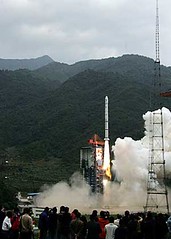Asian Space Race in High Gear
 Earlier this month, we wrote about China’s successful placement of a lunar probe into orbit around the moon, and raised the question of whether a new Asian space race could be said to be afoot.
Earlier this month, we wrote about China’s successful placement of a lunar probe into orbit around the moon, and raised the question of whether a new Asian space race could be said to be afoot.
The Los Angeles Times recently went to Asia to investigate that same question, and found that for China, India and Japan, their ambitions in space are fueled by a desire for recognition as global powers — not to mention entry into the growing commercial satellite market and the potential of lunar mining:
A closer look at Asia’s space balance sheet finds China the clear leader in manned space flight. Beijing also boasts the most extensive infrastructure, with three launch sites in place and a just-announced combined pad and theme park on the drawing board in southern Hainan island.
Also working in China’s favor, said Clay Moltz of the Naval Postgraduate School in Monterey, is solid government backing, its pick of the nation’s scientists and close, if far from transparent, links with the military…..
Japan is ahead of China in areas such as deep-space probes and robotics and enjoys a more focused, high-tech approach. But it suffers from relatively limited budgetary and popular support, and almost no help from the military….
Japan now has a relatively reliable launch system, but the program has had trouble attracting engineers given competition from other industries and a small pool of candidates because of the nation’s low birthrate.
India, meanwhile, has a strong grounding in earth sciences and engineering, an ambitious vision and programs that dovetail well with national development plans. But its program may not garner the budget needed to compete longer term with China, some analysts said.
"China’s resources are 10 times more than us," said Dipankar Banerjee, director of the Institute of Peace and Conflict Studies in New Delhi. "Compared to the Chinese, we still have a long way to go."
China and India see a robust space program as an essential step toward recognition as a global power.
"The space program is viewed as an essential prerequisite for India to be counted amongst the developed nations of the world," said Ranjit Singh Nagra, a military expert.
China’s recent great leap forward into space has generated a lot of heated debate among space fans, as this conversation thread over at Daily Tech exemplifies.
Absent from the LA Times summary, however, is South Korea — a nation that isn’t going to sit back and watch while its regional neighbors pursue the heavens:
Korea plans to develop a powerful two-stage rocket that can send a satellite to the moon by 2017, the government said Tuesday (Nov. 20).
The road map calls for the building and testing of the 300-ton Korea Space Launch Vehicle-1 (KSLV-II) booster rocket so the country can launch its first lunar exploration satellite in 2020, the Ministry of Science and Technology said.
If the plan is successfully carried out, Seoul will launch a lunar probe in 2025, it said…..
It also said efforts will be made to attain technological independence in key rocket systems by 2016 and in commercial satellite production starting in 2020.
Seoul plans to launch a large satellite weighing about 100 kilograms every 3-4 years, and at least two smaller satellites every year.
Even in this new Asian space race, however, there’s no need to fully reinvent the rocket ship. As with India’s lunar ambitions, South Korea has been relying on Russian technology and assistance to develop the Korea Space Launch Vehicle, the two-stage rocket for satellite launches set to debut next year. The 11 satellites South Korea has launched since 1992 for space and ocean observation and communication have all been carried aboard foreign-made rockets launched from other countries.